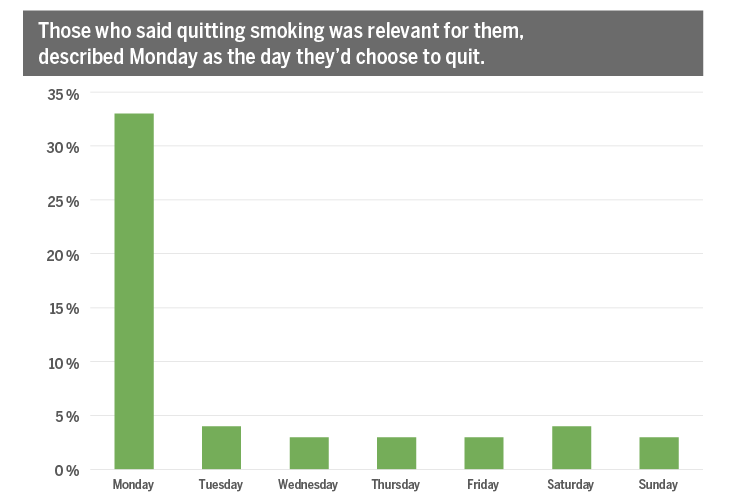





Research About Quit & Stay Quit Monday
A Monday cue to quit and recommit to tobacco cessation goals can benefit smokers of any age or health status.
Committing to quit is an important step as benefits accrue immediately and in the long run. The sooner an individual quits, the sooner their body can begin to heal.1
The Monday Campaigns has worked with the Institute for Global Tobacco Control and the Lerner Center for Public Health Promotion at the Johns Hopkins Bloomberg School of Public Health to explore the ways in which Monday can be a leverage point in helping people quit and stay quit. Key conclusions include:
Monday is the day smokers are most likely to choose as a quit date
According to a nationally representative survey of adult Americans, one third of those who said quitting smoking was relevant for them, described Monday as the day they’d choose to quit.2


Over 40% of survey respondents that use tobacco products have tried to quit in the past thirty days. Of those trying to quit, 60% said that they would make an effort to quit on Monday. They selected Monday two times as much as any other day of the week. This supports research that while the majority of smokers want to quit completely, for many tobacco users, it may take 30 or more quit attempts to be successful.3, 4
People seek cessation services and information more on Monday than other days
A study published in JAMA Internal Medicine showed “quit smoking” query volumes are 25 percent higher on Mondays than other days, amounting to 8 million more quit smoking searches per year on Mondays across 7 different languages.5
An analysis of participant engagement data from Truth Initiative’s “Become an Ex” quit program showed that there are more initial contacts with the online program at the beginning of the week as compared to other times.6 Additionally, an analysis of 16 state quitlines and the US national quit hotline showed that Mondays are the most popular day for calls, with a consistent weekly pattern of a beginning of the week “surge” in call volumes and a decline towards the end of the week and over the weekend.7
Choosing Monday as a quit day increases confidence for quitters
In a pilot conducted with smokers in the State of Maryland counselor-led weekly in-person cessation groups, Johns Hopkins researchers found that those in groups that encouraged using Monday as a quit day were more likely to show increased self-efficacy about quitting at the end of the study than those that did not.8
QSQM programs can increase engagement with tobacco cessation resources
The Pima County Department of Health launched a 12-week QSQM program with assets in Spanish and English. Metrics showed that social media was an effective way to reach high-priority populations and calls to the state quitline increased.
The Virginia Department of Health partnered with QSQM to conduct a 12-week QSQM program. Results showed changes in tobacco usage, plans to change worksite tobacco use policies and utilization of the state quitline.
Further Study of the Monday Approach
Learn about preparing to quit tobacco, the health benefits of tobacco cessation and how to get support for quitting.
For more information about using a Monday cue to support healthy behavior, read The Monday Campaigns Research. Visit our Resources page for more creative material and resources to promote Quit & Stay Quit Monday. Information about previous QSQM programming is available on this document.
[1] Centers for Disease Control and Prevention. 2017. Benefits of quitting. https://www.cdc.gov/tobacco/quit_smoking/how_to_quit/benefits/index.htm
[2] Data Decisions Group. 2019. Nationally representative survey of 1000 adult Americans.
[3] Babb S, Malarcher A, Schauer G, Asman K, Jamal A. 2017. Quitting smoking among adults—United States, 2000–2015. Morbidity and Mortality Weekly Report. https://www.cdc.gov/mmwr/volumes/65/wr/mm6552a1.htm?s_cid=mm6552a1_w%20
[4] Chaiton M, Diemert L, Cohen JE, et al. 2016. Estimating the number of quit attempts it takes to quit smoking successfully in a longitudinal cohort of smokers. BMJ Open. https://pubmed.ncbi.nlm.nih.gov/27288378/
[5] Ayers, J. W., Althouse, B. M., Johnson, M. J., & Cohen, J. E. 2014. Circaseptan (weekly) rhythms in smoking cessation considerations. JAMA Internal Medicine, 174, 146-148. https://jamanetwork.com/journals/jamainternalmedicine/fullarticle/1761921
[6] Welding, K., De Leon, E., Cha, S., Johnson, M.L., Cohen. J., Graham, A. 2017. Weekly enrollment and usage patterns in an Internet smoking cessation intervention. Internet Interventions. Volume 9, September 2017, Pages 100-105. https://www.sciencedirect.com/science/article/pii/S2214782916300331?via%3Dihub#bb0090
[7] Johnson, M.J. 2011. Weekly patterns in usage of tobacco quit lines. Presented to the North American Quitline Consortium. November. https://www.mondaycampaigns.org/wp-content/uploads/2020/05/quitline_periodicity__MJ_2011.pdf
[8] Cohen JE, De Leon E, Crossnohere N, Fuentes L, Johnson M. 2016. Engaging smokers to improve smoking cessation outcomes: Quit and Stay Quit Monday. Poster at the Society for Research on Nicotine and Tobacco Annual Meeting. Chicago, USA. March 2-5, 2016. https://www.jhsph.edu/research/centers-and-institutes/institute-for-global-tobacco-control/_pdfs/posters-and-presentations/2016/poster_16_SRNT_Mondaycampaigns.pdf